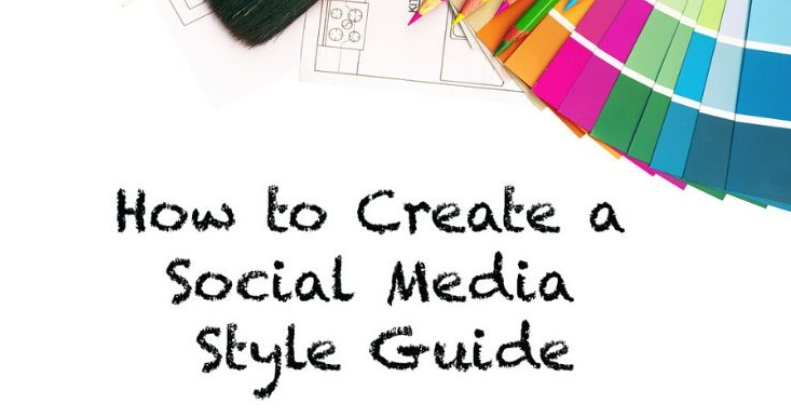A social media style guide is the go-to source for how your brand appears and acts on social. It allows your brand to create a cohesive experience across every profile. Your guide includes brand colors, voice, visual guidelines and everything else that distinguishes your brand on social media. It is a living document that should change and evolve over time. It’s also important to note that a social media style guide is not the same as your social media marketing strategy. Your strategy will consist of more of the tactical information such as what and how often you publish. Essentially, it’s focused on how you’ll reach your social media goals. While your strategy outlines what you plan on doing on social media, your style guide breaks down how those actions should be represented and conveyed.
Why? Because…
- Your brand will have personality
- You’ll show up the right way, to the right people, across all your social accounts and posts
- You’ll win more, fail less, with everyone in the know on your social media team
- Quickly onboard new team members before having them go social
#1: Define Your Brand Identity and Visual guidelines
You need to define:
- Your brand identity
- Your objectives for social media
Hopefully, you already have a brand identity. Check your general marketing plan for a mission statement or positioning statement. If you haven’t written one yet, have a go at filling in the gaps on this basic statement:
The formula is deceptively simple. If you haven’t thought about your brand identity before, be prepared to invest some serious time in completing the sentence above.
Visual Guidelines
Since most social networks are highly visual, your social media style guide should set parameters and standards for any images you share. There are 2 major types of visuals to cover inside your guide:
- Photos, graphics or videos shared within posts
- Profile images and header graphics
If you’ve ever looked at a company’s Instagram feed and noticed that it seems themed or really well put together, it’s usually because it was planned out. For instance, take a look at Tiffany&Co. Their feed is colorful and vibrant, but the posts don’t clash against each other. Within your style guide, you can lay out:
- Brand colors
- Fonts for graphics
- Acceptable color combinations, per network
- Photos of your office and team members
- Logos
With all of your design assets in one location, it’s easier for your team to create and share visuals that don’t look out of place with the rest of your feed.
Use Hashtags
The hashtags you use will vary based on the content or campaign.
- List all of the ones to use for your business
- Identify your branded and campaign specific hashtags
- Know and explain on which platforms to use hashtags (e.g., they’re not as effective on Facebook)
- State how many to use for your Twitter or Instagram posts
- Should they be all lower, upper, or mixed case? List that.
- Those are some starters.
Our guide to using hashtags for every network goes deeper on the subject. As you use hashtags over time, strengthen up this part (all parts, actually) of the guide. The best guides are ones that have been groomed over time and use. Data beats guessing, right?
#2: Declare Your Social Media Marketing Objectives
The first step in crafting your social media style guide is to figure out the why behind your social media presence. What are your goals on social media? Is it to bring in new business? Help customers with your product? Network with industry insiders?
It’ll most likely be a combination of things. It’s ok to pick multiple goals, just don’t confuse your followers with random or inconsistent messages. Here are some goals to choose from:
- Engage an existing audience around your brand or related issue to build loyalty
- Educate potential or existing customers on a topic core to your brand
- Inform potential customers on how your brand will help solve their pain points
- Enable your customers to succeed at what they came to do
- Entertain your audience so they engage and pay attention
- Delight your users by having next level customer service
- Empower your audience to make the best choices for them
- Amplify an issue your brand and its audience stand behind
Write a short paragraph defining these as they relate to you and how you’ll bring them to life through the content you share. For instance, you may want to educate people without patronizing or confusing them and empower and them to learn to become better marketers.
#3: Develop a Persona or Personas
Personas are an essential part of your content strategy. They define who you want to speak to in your content. We engage with our personas not just in our website copy but when we post on social media as well. Have at least one persona featuring your ideal customer characteristics – for example, “CTO Chris” or “Marketing Manager Chris.” These examples are B2B personas, there are also guides available for creating B2C personas that delve into more personal demographics and psychographics. Bring your personas to life. In a B2B persona, focus on solving work-related issues and aligning your brand with the solutions your persona might be experiencing or needing. Do your research. Once you have an idea of who your persona is, find examples of them in real life. Look at who they follow, what they read, where they find information relevant to your offering. Ask them what their interests and true pain points are. You already know how your product or service solves their pain points. Your personas will help you determine how to best speak to your audience in an empathetic and intentional way.
#4: Choose Your Social Networks
The next step is to make a list of all of the social networks your business currently uses. Don’t leave anything off the list, even if it’s a network you’ve neglected recently. If you have an account, put it on the list. Now examine the list critically. Is anything missing? How does each network fit your aims for social media? If you have multiple objectives, as discussed above, you could try sorting your list of social networks into different buckets like reach, convert, and retain.
However, you also need to be realistic at this point. Think about the size and skill set of your team, and ask how many social networks they can reasonably support.
#5: Determine Your Brand Voice (Grammar & Terminology)
Your social media voice is one of the top things that will distinguish your brand from other companies. Your voice should be consistent across all mediums whether it’s commercials, social media ads, Tweets or Instagram posts. For instance, if you’re funny and humorous on Facebook but all of your YouTube videos are serious and straight-laced, it sends mixed messages. We can’t tell you what your social media voice should be since it represents your brand. But it should be reflective of how you want your brand to be perceived. That might mean one or more of the following:
- Friendly
- Helpful
- Casual
- Sarcastic
- Bold
- Energetic
- Cheerful and upbeat
- Formal
- Young and trendy
- Deadpan or dry humor
In order to help find your social media voice, it might be helpful to look back at your past content. Whether it’s a blog post, ad copy or other messaging, pay attention to the tone and emotion conveyed. You can also look at what other brands are doing on social media. You don’t want to just copy another brand’s voice, but it could give you some inspiration. Once you’ve settled on your brand voice, write it down in your social media style guide. The key is to be as descriptive as possible. Don’t simply write:
Voice: Funny
Instead, you might have something along the lines of this:
Voice: Clean and playful humor. Responses should be upbeat, optimistic and positive. Avoid being sarcastic or mocking customers, followers or other brands.
Another helpful tip is to include screenshots with examples of posts from your brand or others that showcase the tone you want to establish. Whoever is reading your social media style guide should be able to pick up on your brand’s voice with ease. Of course, that particular brand voice is not for everyone. But whatever style you settle on, you have to be consistent. As we all know, consistency is a vital element of brand trust. This means that if you decide to change your style, you need to introduce the changes in the right way. There are two options here: You can gradually introduce the new voice or go for a radical restart. One of the famous examples of this was Coca-Cola, which deleted all of their Instagram posts last year so they could start fresh with a campaign for kindness on social media.
Grammar & Terminology
Grammar style guides aren’t just for your website. Your social media posts should follow certain grammatical standards as well. This goes beyond whether or not you use AP Style. It extends to any terminology you use in-house, when to use exclamation points and other things that help create consistency in your content. You can be as detailed as you’d like here, depending on your brand’s preferences. If you already have a grammar handbook for your website or blog, you could carry over a lot of the same rules to your social media style guide.
#6: Detail Your Measurement and Attribution
Most marketers are now convinced of the value of social media. The only difficulty is proving it. That’s where attribution comes in: being able to show where your clicks are coming from. And just like your brand voice, an attribution strategy only works if you use it consistently. So it’s worth setting out the details in your social media style guide. I recommend including a brief explanation of UTMs because it’s surprising how few people actually understand them. You can also list your preferred tools such as the free Campaign URL Builder by Google Analytics.
This is also a good moment to cover other link-related tools such as link shorteners, link services, and quick-fix tools like the Facebook Debugger. If you have specific strategies for sharing links (for instance, on tricky networks like Instagram or LinkedIn), then explain them in detail.
Now, go ‘nail it’ by creating your social media style guide, to make your strategy happen.





